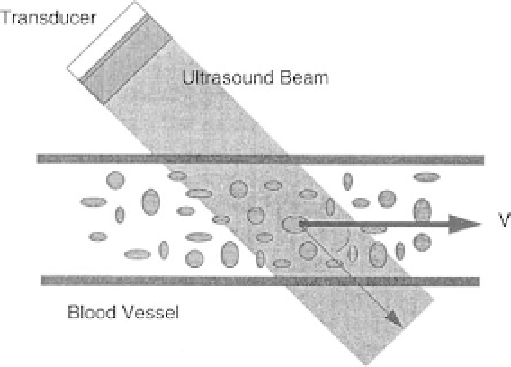Biomedical Engineering Reference
In-Depth Information
FIGURE 16.25
Sound beam intersecting blood moving at velocity
v
in a vessel tilted at angle
y
.
precision of the Doppler modes, color flow imaging provides a real-time view of the
approximate velocity and direction of blood flow. This information is represented by
mapping of colors assigned to the velocity magnitude and direction (toward or away from
the transducer). In this mode, several acoustic lines are sent in the same direction to obtain
flow information over time, and then signal processing extracts the velocity information for
display. A second type of Doppler image is called power Doppler, in which the amplitude
of the flow is presented but not the direction, as illustrated by the top of Figure 16.17.
Most ultrasound imaging is two-dimensional in that a picture is created in an imaging or
scan plane. A three-dimensional (3D) image can be created by scanning a volume rather
than a plane. By mechanically moving the array in a direction perpendicular to the imaging
planes, pausing long enough to acquire each image plane, and interpolating between
planes, it is possible to fill in the overall volume with image data. The 3D images can be
viewed in selected cut planes through the volumes or through surface or volume rendering.
For example, a common application is 3D imaging of the fetus through surface rendering, in
which the boundary between the fetal skin and amniotic fluid is used to create a 3D opaque
surface (Figure 16.26). Volume rendering allows internal details of organs to be visualized
through transparent boundaries between organs and layers. Images can also be formed
through other ways of creating a set of volume data by different mechanical scanning tech-
niques or by complete electronic scanning by a stationary two-dimensional array.
16.3 MAGNETIC RESONANCE IMAGING
16.3.1 Introduction
Magnetic resonance has been applied successfully to medical imaging of the body
because of its high water content. The hydrogen atoms in water (H
2
O) and fat make up
approximately 60 percent of the body by weight. Because there is a proton in the nucleus
of each hydrogen atom, as the nucleus spins, a small magnetic field or moment is created.




